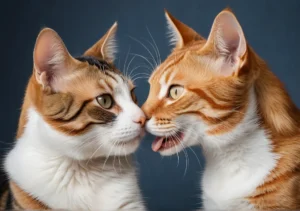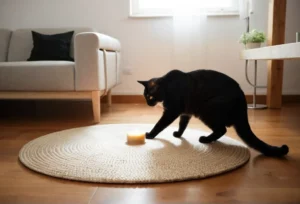Are you curious why cats can be so mean to each other? Let’s explore the reasons behind their behavior and gain a better understanding of their complex social dynamics.
Cats are territorial animals by nature, which can lead to conflicts and aggressive interactions with other cats. Understanding the reasons behind their behavior can help us comprehend their actions and develop strategies to help them coexist peacefully. Let’s take a closer look at why cats can be mean to each other.
Instinctual Behavior
Cats are solitary creatures by nature, instinctively wired to protect their territory from intruders. This territorial behavior often leads to aggression towards other cats that dare to encroach upon their space. This instinct dates back to their wild ancestors who needed to defend their resources to survive. So, when your cat hisses or swats at another feline, it’s not personal – it’s just their natural instinct kicking in.
Social Hierarchy
Cats are not just loners; they also have a complex social structure within their colonies. Establishing a social hierarchy is crucial for maintaining order and reducing conflict. This hierarchy is often determined through dominance struggles, where cats assert their power and status through various behaviors, including aggression. So, when you see your cats battling it out for the top spot, it’s all part of their natural instinct to establish their place in the pecking order.
Unique Insight: It’s essential to provide multiple resources such as food, water, and litter boxes in multi-cat households to reduce the chances of conflict over these critical resources. By ensuring each cat has access to their essentials, you can help minimize tension and promote harmony among your feline friends.
Lack of Socialization
When cats are young, they learn how to interact with others through socialization. Lack of proper socialization can lead to misunderstandings and conflicts between cats. Just like us humans, cats need to learn social skills early on to get along with their peers. Without this early exposure to other cats, they may struggle to communicate effectively and resort to aggressive behaviors when interacting with other felines. So, if your cat missed out on those important socializing moments as a kitten, it might explain why they are mean to other cats now.
Resource Competition
Competition for resources like food, water, and shelter can stir up some serious cat drama. When resources are limited, cats might feel the need to defend what they have, leading to aggressive behavior towards other cats. It’s like when you’re fighting for the last slice of pizza with a sibling – things can get pretty intense. To reduce conflicts over resources, make sure each cat has their own separate feeding and water stations. Giving each cat their own space can help minimize competition and promote harmony in your feline household.
Additional Insight: Environmental Enrichment
In addition to resource competition, a lack of environmental enrichment can also contribute to cats being mean to each other. Cats are intelligent and active animals that need mental and physical stimulation to thrive. Without enough toys, scratching posts, and safe spaces to explore, cats can get bored and frustrated, leading to aggressive behavior towards their feline housemates. Providing plenty of enrichment for your cats can help reduce stress and conflict, making for a happier and more harmonious multi-cat home.
Fear and Insecurity
Fear and insecurity can play a significant role in causing cats to be mean to each other. When cats feel threatened or insecure in unfamiliar or stressful situations, they may exhibit defensive aggression towards other felines. This behavior serves as a way for cats to protect themselves and establish boundaries, especially when they feel at risk. It’s essential to understand that cats, like humans, can experience fear and insecurity, which can manifest in their interactions with other cats. Providing a safe and secure environment, along with positive reinforcement, can help alleviate these feelings and reduce aggressive behavior in cats.
Redirected Aggression
Redirected aggression is another factor that may contribute to cats being mean to each other. This occurs when a cat experiences frustration or stress from an unrelated trigger and then directs their aggression towards another feline. For example, if a cat sees a bird outside but cannot reach it, they may become frustrated and take out this frustration on another cat in the household. Understanding redirected aggression is crucial in managing inter-cat conflicts. By identifying and addressing the underlying triggers of aggression, such as environmental enrichment and providing appropriate outlets for natural behaviors like hunting, pet owners can help prevent redirected aggression and reduce conflicts between their cats.
Helpful Tips:
– Provide vertical space for your cats to climb and perch on, reducing competition for territory.
– Encourage play and interactive toys to channel your cat’s energy positively.
– Utilize pheromone diffusers to create a calming environment for your cats.
Medical Issues
When cats are being mean to each other, it could be a sign of underlying medical issues causing discomfort or pain. If a cat is in pain, aggressive behavior towards another cat may be a way of expressing that discomfort. Health problems like dental issues, arthritis, or urinary tract infections can impact a cat’s behavior and make them lash out at their feline companions.
If you notice sudden aggression between your cats, it’s crucial to take them to the veterinarian for a thorough check-up. Addressing any medical problems can help improve their behavior towards each other as they will no longer be in pain or distress. Don’t ignore potential health issues as they could be the root cause of your cat’s uncharacteristic hostility towards their housemates.
Behavioral Interventions
To help cats get along better in a multi-cat household, consider utilizing behavioral interventions to reduce aggressive interactions and create a more harmonious environment for all your feline friends. Start by ensuring each cat has their own space, food, water, and litter box to minimize competition and territorial disputes.
Engage in regular interactive play sessions with your cats separately to burn off excess energy and reduce tension between them. Provide plenty of vertical space, hiding spots, and cozy bedding to allow each cat to retreat and feel safe when needed. Using pheromone diffusers or sprays can also help calm your cats and reduce conflict in the household.
Additionally, consider implementing a reward-based training program to reinforce positive behavior and encourage socialization between your cats. Consult with a veterinarian or animal behavior expert for personalized advice on addressing specific behavioral issues in your cat family.
Extra tip: Regularly monitor your cats’ interactions and look for any triggers or patterns of aggression to better understand their behavior and make targeted interventions.
Fun Facts About Cat Behavior
Did you know that cats are actually solitary animals by nature? This means that they are not naturally inclined to share their space with other felines, which can sometimes lead to conflicts and aggression. While some cats may get along well with each other, it’s important to understand that their behavior is influenced by their innate instincts.
One interesting fact about cat behavior is that they use scent to communicate with each other. Cats have scent glands on their bodies, especially around their faces, which they use to mark their territory. When cats feel threatened or insecure, they may exhibit aggressive behavior towards other cats to establish dominance and protect their space.
Another fun fact is that cats are highly territorial creatures. They have a strong need to establish and defend their territory, which can sometimes result in aggressive interactions with other cats. Understanding this aspect of their behavior can help us create environments where cats feel secure and less likely to be mean to each other.
By learning more about these fascinating aspects of feline behavior, we can better understand why cats can be mean to each other and take steps to create a more harmonious living space for our furry friends.
Factors that Contribute to Cats Being Mean to Each Other
- Resource Competition: Cats can become aggressive towards each other when they feel like their resources, such as food, water, or attention, are being threatened. Make sure to provide separate resources for each cat to minimize conflict.
- Social Structure: Cats have a complex social hierarchy, and conflicts may arise when trying to establish dominance within a group. Providing multiple hiding spots and vertical spaces can help cats navigate their social dynamics more peacefully.
- Stress and Anxiety: Cats can exhibit mean behavior towards each other when they are feeling stressed or anxious. Create a calm and secure environment for your cats by providing them with plenty of opportunities to play, relax, and hide.
Understanding these contributing factors can help us address the root causes of aggression among cats and promote a more peaceful coexistence among our furry companions.
Alex, a passionate animal lover, has experience in training and understanding animal behavior. As a proud pet parent to two dogs and three cats, he founded AnimalReport.net to share insights from animal experts and expand his knowledge of the animal kingdom.




